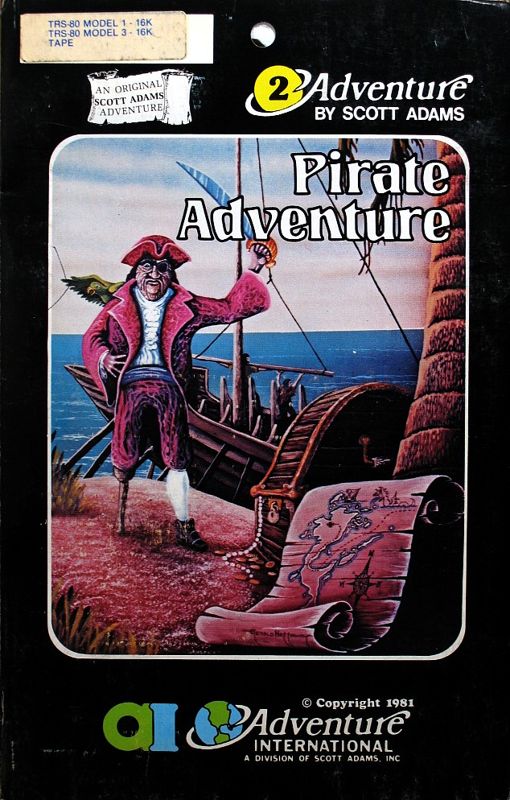Retro Replay Review
Gameplay
Pirate Adventure continues the tradition of early text-based interactive fiction by offering a straightforward yet engaging command-driven system. Players navigate the game world by entering simple one- or two-word commands such as NORTH, GET SNEAKERS, or INVENTORY. The parser’s forgiving nature—recognizing commands from the first three letters—ensures that newcomers to the genre can focus on exploration rather than memorizing complex syntax.
(HEY YOU!! We hope you enjoy! We try not to run ads. So basically, this is a very expensive hobby running this site. Please consider joining us for updates, forums, and more. Network w/ us to make some cash or friends while retro gaming, and you can win some free retro games for posting. Okay, carry on 👍)
The game unfolds across three distinct locales: a modest London flat and two perilous islands teeming with hostile critters and cunning adversaries. This triad of settings provides a satisfying contrast, as the safe yet unremarkable flat serves as a brief respite before plunging into the island jungles and rocky shores. Each environment is packed with interactive objects and hidden nooks, encouraging careful examination and experimentation.
Puzzle design in Pirate Adventure strikes a balance between logical challenge and fair play. Players must gather tools, combine items creatively, and solve environmental puzzles to track down the two pirate treasures hidden on Treasure Island. While some solutions require lateral thinking—such as using non-obvious objects in inventive ways—the game’s clear feedback loop ensures that progress feels earned rather than arbitrary.
Graphics
As a pure text adventure, Pirate Adventure dispenses entirely with visuals, relying on descriptive prose to paint its world. Despite the lack of graphical assets, the narrative descriptions are vivid enough to evoke lush jungle landscapes, creaking shipwrecks, and cramped London rooms. The absence of images allows the player’s imagination to flourish, filling in details and making each discovery feel personal.
The game’s textual presentation is clean and uncluttered, with prompt feedback after each command. There are no distracting menus or status bars—only the story unfolding line by line. This minimalist approach keeps the focus on exploration and puzzle-solving, and for many enthusiasts of the genre, it recalls the golden age of home computer gaming in the late 1970s and early 1980s.
While players accustomed to modern visuals might find the text-only format sparse, those who appreciate interactive fiction will recognize the strength of the written word. Well-crafted descriptions of hostile wildlife, hidden caves, and pirate loot instill a sense of place often missing in early graphical adventures. In this sense, Pirate Adventure’s “graphics” are a celebration of imagination over polygons.
Story
Pirate Adventure casts you as an intrepid explorer drawn into a quest for buried pirate treasure. The narrative premise is simple but effective: unearth two hidden treasures on a remote island, all while avoiding snakes, ghosts, and unscrupulous treasure hunters. Scott Adams’s signature blend of mystery and danger keeps players on their toes as they navigate both natural and human threats.
The storyline progresses organically through exploration rather than cutscenes or dialogue trees. Each successful puzzle solution reveals a new twist or clue, from discovering a cryptic map fragment in London to deciphering a pirate’s journal on the island. These breadcrumbs maintain a steady narrative momentum without overwhelming the player with exposition.
Although character interaction is limited—most NPCs appear as static obstacles or hints—this sparse approach keeps the focus squarely on the environment and the hunt for treasure. The sense of isolation on the island is palpable, and even small narrative flourishes, such as finding torn pirate flags or hearing distant cannons, heighten the immersive atmosphere.
Overall Experience
Pirate Adventure offers a compact yet satisfying journey into the world of text adventures. Its blend of exploration, puzzle-solving, and evocative storytelling makes it a standout entry in Scott Adams’s early catalog. The game’s moderate length ensures that sessions remain engaging, and its puzzles provide just the right amount of challenge for both newcomers and veteran adventurers.
The lack of graphics and sound may feel archaic to some modern gamers, but it is precisely this simplicity that gives Pirate Adventure its charm. Without the distraction of flashy effects, players can immerse themselves fully in the narrative and let their imaginations bring the pirate-infested islands to life. For fans of classic interactive fiction, this title remains a treasured relic of the genre’s formative years.
In sum, Pirate Adventure is a must-play for anyone interested in the roots of adventure gaming. Its intuitive parser, cleverly designed locales, and atmospheric storytelling combine to deliver an experience that is as engaging today as it was upon its original release. Whether you’re a seasoned adventurer or a curious newcomer, setting sail for pirate treasure with this timeless classic is an adventure well worth undertaking.
 Retro Replay Retro Replay gaming reviews, news, emulation, geek stuff and more!
Retro Replay Retro Replay gaming reviews, news, emulation, geek stuff and more!









Reviews
There are no reviews yet.